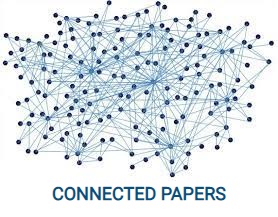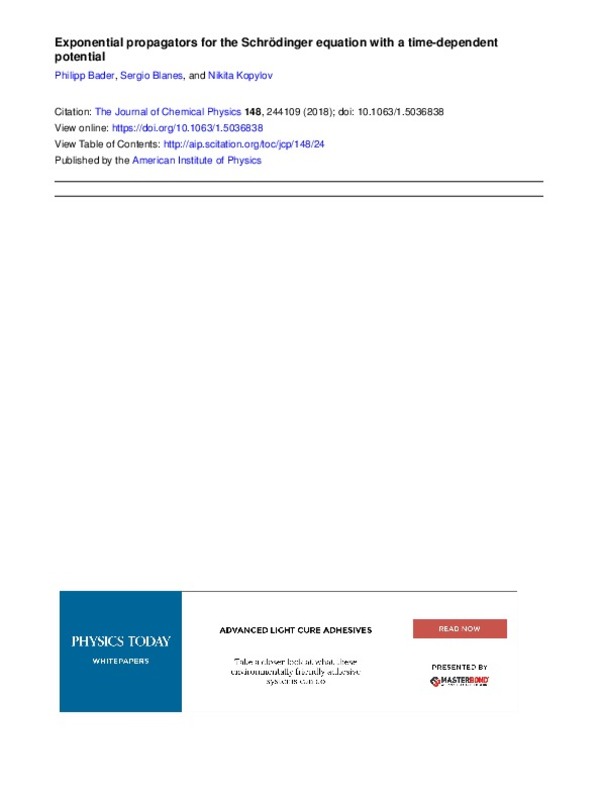JavaScript is disabled for your browser. Some features of this site may not work without it.
Buscar en RiuNet
Listar
Mi cuenta
Estadísticas
Ayuda RiuNet
Admin. UPV
Exponential propagators for the Schrödinger equation with a time-dependent potential
Mostrar el registro sencillo del ítem
Ficheros en el ítem
| dc.contributor.author | Bader, Philipp
|
es_ES |
| dc.contributor.author | Kopylov, Nikita
|
es_ES |
| dc.contributor.author | Blanes Zamora, Sergio
|
es_ES |
| dc.date.accessioned | 2019-05-11T20:04:07Z | |
| dc.date.available | 2019-05-11T20:04:07Z | |
| dc.date.issued | 2018 | es_ES |
| dc.identifier.issn | 0021-9606 | es_ES |
| dc.identifier.uri | http://hdl.handle.net/10251/120355 | |
| dc.description.abstract | [EN] We consider the numerical integration of the Schrodinger equation with a time-dependent Hamiltonian given as the sum of the kinetic energy and a time-dependent potential. Commutator-free (CF) propagators are exponential propagators that have shown to be highly efficient for general time-dependent Hamiltonians. We propose new CF propagators that are tailored for Hamiltonians of the said structure, showing a considerably improved performance. We obtain new fourth-and sixth-order CF propagators as well as a novel sixth-order propagator that incorporates a double commutator that only depends on coordinates, so this term can be considered as cost-free. The algorithms require the computation of the action of exponentials on a vector similar to the well-known exponential midpoint propagator, and this is carried out using the Lanczos method. We illustrate the performance of the new methods on several numerical examples. Published by AIP Publishing. | es_ES |
| dc.description.sponsorship | We wish to acknowledge Fernando Casas for his help in the construction of the methods Upsilon<INF>3</INF><SUP>[6]</SUP>. The authors acknowledge Ministerio de Economia y Competitividad (Spain) for financial support through Project No. MTM2016-77660-P (AEI/FEDER, UE). Additionally, Kopylov has been partly supported by Grant No. GRISOLIA/2015/A/137 from the Generalitat Valenciana. | es_ES |
| dc.language | Inglés | es_ES |
| dc.publisher | American Institute of Physics | es_ES |
| dc.relation.ispartof | The Journal of Chemical Physics | es_ES |
| dc.rights | Reserva de todos los derechos | es_ES |
| dc.subject.classification | MATEMATICA APLICADA | es_ES |
| dc.title | Exponential propagators for the Schrödinger equation with a time-dependent potential | es_ES |
| dc.type | Artículo | es_ES |
| dc.identifier.doi | 10.1063/1.5036838 | es_ES |
| dc.relation.projectID | info:eu-repo/grantAgreement/MINECO//MTM2016-77660-P/ES/NUEVOS RETOS EN INTEGRACION NUMERICA: FUNDAMENTOS ALGEBRAICOS, METODOS DE ESCISION, METODOS DE MONTECARLO Y OTRAS APLICACIONES/ | |
| dc.relation.projectID | info:eu-repo/grantAgreement/GVA//GRISOLIA%2F2015%2FA%2F137/ | |
| dc.rights.accessRights | Abierto | es_ES |
| dc.contributor.affiliation | Universitat Politècnica de València. Departamento de Matemática Aplicada - Departament de Matemàtica Aplicada | es_ES |
| dc.description.bibliographicCitation | Bader, P.; Kopylov, N.; Blanes Zamora, S. (2018). Exponential propagators for the Schrödinger equation with a time-dependent potential. The Journal of Chemical Physics. 149(24):1-7. https://doi.org/10.1063/1.5036838 | es_ES |
| dc.description.accrualMethod | S | es_ES |
| dc.relation.publisherversion | http://doi.org/10.1063/1.5036838 | es_ES |
| dc.description.upvformatpinicio | 1 | es_ES |
| dc.description.upvformatpfin | 7 | es_ES |
| dc.type.version | info:eu-repo/semantics/publishedVersion | es_ES |
| dc.description.volume | 149 | es_ES |
| dc.description.issue | 24 | es_ES |
| dc.identifier.pmid | 29960306 | |
| dc.relation.pasarela | S\363735 | es_ES |
| dc.contributor.funder | Ministerio de Economía y Competitividad | |
| dc.contributor.funder | Generalitat Valenciana | |
| dc.description.references | Bader, P., Iserles, A., Kropielnicka, K., & Singh, P. (2014). Effective Approximation for the Semiclassical Schrödinger Equation. Foundations of Computational Mathematics, 14(4), 689-720. doi:10.1007/s10208-013-9182-8 | es_ES |
| dc.description.references | Bader, P., Iserles, A., Kropielnicka, K., & Singh, P. (2016). Efficient methods for linear Schrödinger equation in the semiclassical regime with time-dependent potential. Proceedings of the Royal Society A: Mathematical, Physical and Engineering Sciences, 472(2193), 20150733. doi:10.1098/rspa.2015.0733 | es_ES |
| dc.description.references | Lubich, C. (2008). From Quantum to Classical Molecular Dynamics: Reduced Models and Numerical Analysis. doi:10.4171/067 | es_ES |
| dc.description.references | Feit, M. ., Fleck, J. ., & Steiger, A. (1982). Solution of the Schrödinger equation by a spectral method. Journal of Computational Physics, 47(3), 412-433. doi:10.1016/0021-9991(82)90091-2 | es_ES |
| dc.description.references | Tremblay, J. C., & Carrington, T. (2004). Using preconditioned adaptive step size Runge-Kutta methods for solving the time-dependent Schrödinger equation. The Journal of Chemical Physics, 121(23), 11535-11541. doi:10.1063/1.1814103 | es_ES |
| dc.description.references | Sanz‐Serna, J. M., & Portillo, A. (1996). Classical numerical integrators for wave‐packet dynamics. The Journal of Chemical Physics, 104(6), 2349-2355. doi:10.1063/1.470930 | es_ES |
| dc.description.references | Kormann, K., Holmgren, S., & Karlsson, H. O. (2008). Accurate time propagation for the Schrödinger equation with an explicitly time-dependent Hamiltonian. The Journal of Chemical Physics, 128(18), 184101. doi:10.1063/1.2916581 | es_ES |
| dc.description.references | Peskin, U., Kosloff, R., & Moiseyev, N. (1994). The solution of the time dependent Schrödinger equation by the (t,t’) method: The use of global polynomial propagators for time dependent Hamiltonians. The Journal of Chemical Physics, 100(12), 8849-8855. doi:10.1063/1.466739 | es_ES |
| dc.description.references | Castro, A., Marques, M. A. L., & Rubio, A. (2004). Propagators for the time-dependent Kohn–Sham equations. The Journal of Chemical Physics, 121(8), 3425-3433. doi:10.1063/1.1774980 | es_ES |
| dc.description.references | Blanes, S., Casas, F., & Murua, A. (2017). Symplectic time-average propagators for the Schrödinger equation with a time-dependent Hamiltonian. The Journal of Chemical Physics, 146(11), 114109. doi:10.1063/1.4978410 | es_ES |
| dc.description.references | Blanes, S., Casas, F., & Murua, A. (2015). An efficient algorithm based on splitting for the time integration of the Schrödinger equation. Journal of Computational Physics, 303, 396-412. doi:10.1016/j.jcp.2015.09.047 | es_ES |
| dc.description.references | Gray, S. K., & Verosky, J. M. (1994). Classical Hamiltonian structures in wave packet dynamics. The Journal of Chemical Physics, 100(7), 5011-5022. doi:10.1063/1.467219 | es_ES |
| dc.description.references | McLachlan, R. I., & Quispel, G. R. W. (2002). Splitting methods. Acta Numerica, 11, 341-434. doi:10.1017/s0962492902000053 | es_ES |
| dc.description.references | Neuhauser, C., & Thalhammer, M. (2009). On the convergence of splitting methods for linear evolutionary Schrödinger equations involving an unbounded potential. BIT Numerical Mathematics, 49(1), 199-215. doi:10.1007/s10543-009-0215-2 | es_ES |
| dc.description.references | Thalhammer, M. (2008). High-Order Exponential Operator Splitting Methods for Time-Dependent Schrödinger Equations. SIAM Journal on Numerical Analysis, 46(4), 2022-2038. doi:10.1137/060674636 | es_ES |
| dc.description.references | Thalhammer, M. (2012). Convergence Analysis of High-Order Time-Splitting Pseudospectral Methods for Nonlinear Schrödinger Equations. SIAM Journal on Numerical Analysis, 50(6), 3231-3258. doi:10.1137/120866373 | es_ES |
| dc.description.references | Gray, S. K., & Manolopoulos, D. E. (1996). Symplectic integrators tailored to the time‐dependent Schrödinger equation. The Journal of Chemical Physics, 104(18), 7099-7112. doi:10.1063/1.471428 | es_ES |
| dc.description.references | Sanz-Serna, J. M., & Calvo, M. P. (1994). Numerical Hamiltonian Problems. doi:10.1007/978-1-4899-3093-4 | es_ES |
| dc.description.references | Saad, Y. (1992). Analysis of Some Krylov Subspace Approximations to the Matrix Exponential Operator. SIAM Journal on Numerical Analysis, 29(1), 209-228. doi:10.1137/0729014 | es_ES |
| dc.description.references | Park, T. J., & Light, J. C. (1986). Unitary quantum time evolution by iterative Lanczos reduction. The Journal of Chemical Physics, 85(10), 5870-5876. doi:10.1063/1.451548 | es_ES |
| dc.description.references | Blanes, S., & Moan, P. C. (2000). Splitting methods for the time-dependent Schrödinger equation. Physics Letters A, 265(1-2), 35-42. doi:10.1016/s0375-9601(99)00866-x | es_ES |
| dc.description.references | Magnus, W. (1954). On the exponential solution of differential equations for a linear operator. Communications on Pure and Applied Mathematics, 7(4), 649-673. doi:10.1002/cpa.3160070404 | es_ES |
| dc.description.references | Blanes, S., Casas, F., Oteo, J. A., & Ros, J. (2009). The Magnus expansion and some of its applications. Physics Reports, 470(5-6), 151-238. doi:10.1016/j.physrep.2008.11.001 | es_ES |
| dc.description.references | Blanes, S., & Moan, P. C. (2006). Fourth- and sixth-order commutator-free Magnus integrators for linear and non-linear dynamical systems. Applied Numerical Mathematics, 56(12), 1519-1537. doi:10.1016/j.apnum.2005.11.004 | es_ES |
| dc.description.references | Thalhammer, M. (2006). A fourth-order commutator-free exponential integrator for nonautonomous differential equations. SIAM Journal on Numerical Analysis, 44(2), 851-864. doi:10.1137/05063042 | es_ES |
| dc.description.references | Alvermann, A., & Fehske, H. (2011). High-order commutator-free exponential time-propagation of driven quantum systems. Journal of Computational Physics, 230(15), 5930-5956. doi:10.1016/j.jcp.2011.04.006 | es_ES |
| dc.description.references | Auer, N., Einkemmer, L., Kandolf, P., & Ostermann, A. (2018). Magnus integrators on multicore CPUs and GPUs. Computer Physics Communications, 228, 115-122. doi:10.1016/j.cpc.2018.02.019 | es_ES |
| dc.description.references | Munthe–Kaas, H., & Owren, B. (1999). Computations in a free Lie algebra. Philosophical Transactions of the Royal Society of London. Series A: Mathematical, Physical and Engineering Sciences, 357(1754), 957-981. doi:10.1098/rsta.1999.0361 | es_ES |
| dc.description.references | Bader, P., Blanes, S., Ponsoda, E., & Seydaoğlu, M. (2017). Symplectic integrators for the matrix Hill equation. Journal of Computational and Applied Mathematics, 316, 47-59. doi:10.1016/j.cam.2016.09.041 | es_ES |
| dc.description.references | P.V. Koseleff, “Formal calculus for Lie methods in Hamiltonian mechanics,” Ph.D. thesis, Lawrence Berkeley Laboratory, 1994. | es_ES |
| dc.description.references | Chin, S. A. (1997). Symplectic integrators from composite operator factorizations. Physics Letters A, 226(6), 344-348. doi:10.1016/s0375-9601(97)00003-0 | es_ES |
| dc.description.references | Omelyan, I. P., Mryglod, I. M., & Folk, R. (2002). Construction of high-order force-gradient algorithms for integration of motion in classical and quantum systems. Physical Review E, 66(2). doi:10.1103/physreve.66.026701 | es_ES |
| dc.description.references | Walker, R. B., & Preston, R. K. (1977). Quantum versus classical dynamics in the treatment of multiple photon excitation of the anharmonic oscillator. The Journal of Chemical Physics, 67(5), 2017. doi:10.1063/1.435085 | es_ES |
| dc.description.references | Iserles, A., Kropielnicka, K., & Singh, P. (2018). Magnus--Lanczos Methods with Simplified Commutators for the Schrödinger Equation with a Time-Dependent Potential. SIAM Journal on Numerical Analysis, 56(3), 1547-1569. doi:10.1137/17m1149833 | es_ES |








